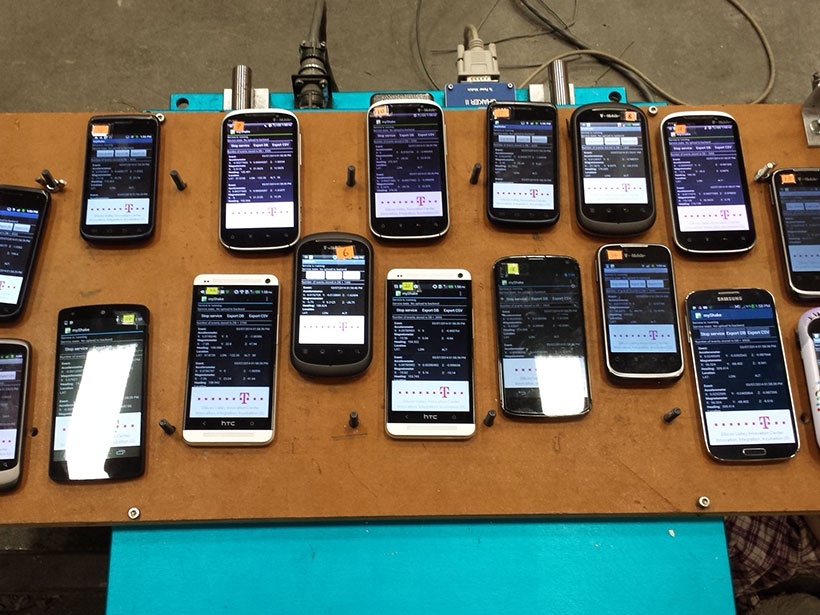At the Seismological Society of America (SSA) meeting last week, in a session on “Citizen Seismology,” researchers from around the globe presented their crowdsourced earthquake detection networks.
From cell phone apps to sensors in basements, these projects recruit ordinary people to gather and report data on nearby earthquakes. They generate dense networks of sensors while also teaching their citizen volunteers about earthquakes.

Made possible by the advent of the Internet and smartphones, this distributed way of gathering data can sometimes make up for shortfalls of traditional precision seismograph networks, seismologists said. For instance, citizen science networks can sometimes outpace traditional earthquake monitoring networks in reporting to a central database and may form denser networks than the conventional ones, enabling seismologists to more quickly triangulate on an earthquake’s epicenter. What’s more, they can capture the actual impact of an earthquake on peoples’ lives, U.S. Geological Survey (USGS) analyst Vincent Quitoriano, who works on a quake detection website called “Did You Feel It?” (see below), told Eos.
Because these novel quake monitoring projects engage volunteers and turn them into a larger scientific workforce, “there’s more education happening, there’s more research happening. People are just more involved in their communities,” Danielle Sumy, a seismologist with the Incorporated Research Institutions for Seismology in Washington, D. C., told Eos. She works on the California-based Quake-Catcher Network project (see below).
Each project has its own scope, focus, and means of detecting earthquakes; here are five of them:
- MyShake This app for Android phones relies on the phone’s internal sensor to detect ongoing quakes. Place the phone on a flat surface, leave it alone for half an hour to calibrate, and it will begin “listening” for tremors that disturb the phone’s built-in accelerometer. Anything that fits the profile of an earthquake gets automatically reported to the MyShake database. The MyShake team at the University of California, Berkeley, hopes to eventually build a global network of MyShake users and to produce an iPhone version of the app.
- LastQuake Like MyShake, LastQuake is an app for smartphones—but this one relies on volunteer reporting, rather than the phone’s internal hardware. The LastQuake system, created by a team at the European-Mediterranean Seismological Centre in Essonne, France, sifts through Internet traffic on Twitter and other public networks, looking for reports of tremors. Users located near earthquake epicenters can fill out a questionnaire to rank the earthquake’s intensity.
- AcceleROB Not all earthquake crowdsourcing requires a smartphone: Across Belgium, in quiet garages and basements, a network of cheap, boxy sensors attached to bricks is listening for tremors. The AcceleROB program, run by the Royal Observatory of Belgium in Brussels, has asked volunteers to host its cheap, low-power, Internet-connected accelerometers in their homes. So far, only 28 households across Belgium have done so, but the program hopes to send out 70 more sensors, allowing its team to monitor the whole country.
- Quake-Catcher Network This project works much like AcceleROB on a global scale: Teachers and other hosts can ask for a sensor that can be taped to the floor and plugged into a computer by means of a USB cable. The sensor then constantly monitors tremors, broadcasting any disturbance back to the project leaders at the California-based Quake-Catcher Network (QCN). The project also has an educational component: The project leads are trying to get more schools involved, distributing lesson plans on the QCN website.
- Did You Feel It? The USGS has its own earthquake-watching project that gets its input from questionnaires. For 20 years, users anywhere in the world have been able to fill out an online form when they feel a quake, answering such questions as “Did you notice any swinging of doors or other free-hanging objects?” The program takes the answers and aggregates them with other local reports to assign an intensity to the quake. The team is currently building a prototype system of volunteer reporting that they hope will be able to gather earthquake location and intensity data faster than traditional seismograph networks.
For most of these projects, seismologists seemed encouraged by the responsiveness of citizen-scientists. “For a very large earthquake, we’ll get around 20,000–30,000 responses in the US,” Quitoriano told Eos. “For smaller earthquakes, we’ll get on the order of 5000–6000.”
“They’ve proved very useful in environments where other sensors that might not be on the right scale have failed.”
Seismological research has benefited from these new data sources. For instance, during a recent Alaskan earthquake, seismometers tuned to monitor lower-magnitude tremors became oversaturated by the quake’s intensity. “But some of the USB sensors that we had in schools were able to get really accurate recordings,” said Sumy. “So they’ve proved very useful in environments where other sensors that might not be on the right scale have failed.”
At the SSA meeting, which took place in Reno, Nev., the different groups were able to meet and share their data. Some of the researchers have said they hope to interconnect citizen science networks with traditional instruments to collect data from both simultaneously, which should result in more quickly available and accurate online earthquake maps. “In the future, we’re hoping to have a convergence of data streams,” said Quitoriano. “There’s still some work to be done, but I can see that that’s the direction we’re heading in.”
—Elizabeth Deatrick, Writer Intern
Citation: Deatrick, E. (2016), Crowdsourced seismology, Eos, 97, doi:10.1029/2016EO051335. Published on 26 April 2016.
Text © 2016. The authors. CC BY-NC-ND 3.0
Except where otherwise noted, images are subject to copyright. Any reuse without express permission from the copyright owner is prohibited.

